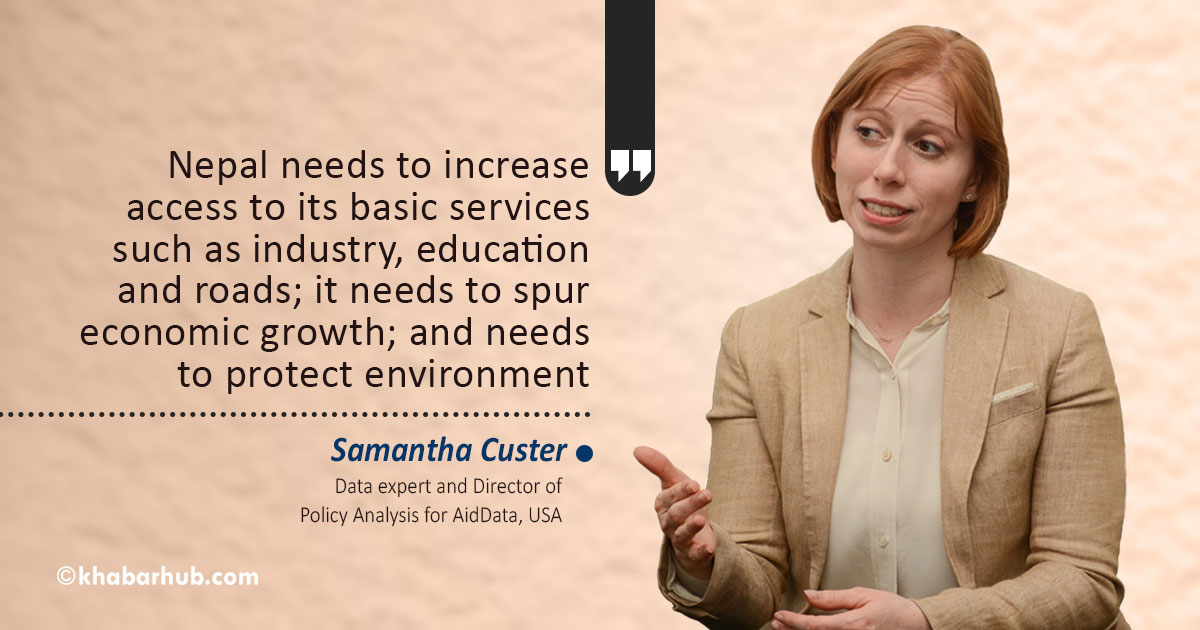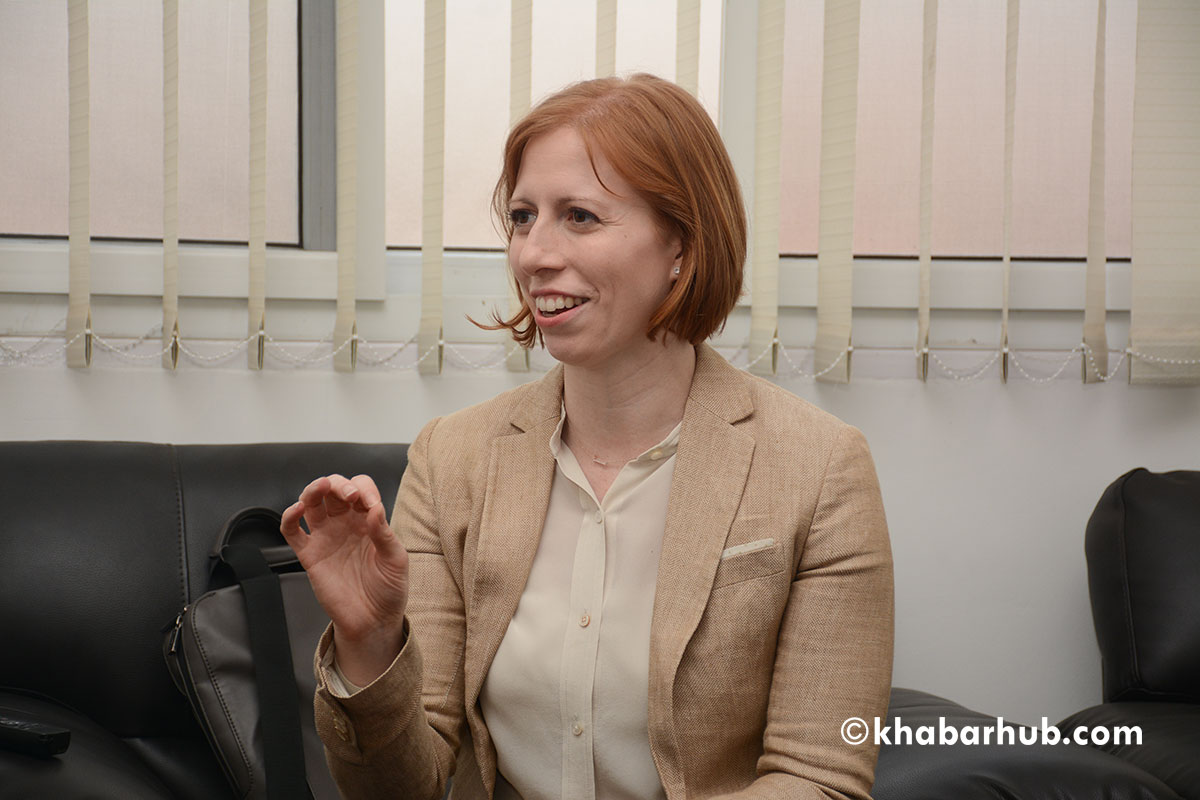0%

Samantha Custer, the Director of Policy Analysis for AidData in the United States was in Nepal recently. The co-author of World Bank papers on open data and citizen feedback with the Open Development Technology Alliance, Samantha has also assisted former US Secretary of State Madeleine Albright to teach a class on foreign policy. Samantha previously advised on multilingual education policy with SIL International and coordinated the advocacy efforts of the Asia Multilingual Education Working Group for UNESCO. While in Nepal, she talked to Khabarhub on various issues, including responsible infrastructure, foreign aid, among other issues. Excerpts:
‘Responsible Infrastructure’ is a little known phrase. Could you explain a little bit about this?
Well, when we talk about infrastructure, it has two different types. Physical infrastructure such as roads, ports, etc – things that help connect Nepal to the outside world for trade.
There is also the digital infrastructure that connects people by the internet, television, phone or the media. When it comes to thinking about what makes infrastructure responsible, we essentially think about investments that have wings such as economic, social and environmental, and also the present day and the future.

So, before making an infrastructure, the concern should be to ensure that it’s there to stay for the future. And when it comes to investments, the idea is that it is very expensive to be able to be developed. Therefore, sourcing the right financing that makes sense to that infrastructure is what has to be emphasized.
What should a country like Nepal ensure while selecting aid investment?
The good news is that for countries like Nepal, there are more traces like finance as well as finding financial partners than ever before.
There have been a lot of new different donors — interested in infrastructure — that are coming to the table. And so, when it comes to choosing, resource financing is significant.
First, in order to access finance stay, we need to think about how much do we have to repay tomorrow? Different types of financing come with different terms. And so, we have grants and low-interest loans, which are not very expensive to repay. Sometimes, you may not have to repay loans. On the other hand, you have a lot of market loans that you have to repay.
Can we take the example of the grants that the United States has been providing to Nepal?
Indeed. They are grant-based assistance. But in commercial loans, they basically have an interest rate. The second question is what are all the costs accessing the infrastructure?
For example, many commercial loans require collateral. For example, Sri Lanka’s port in exchange for financing. So, if they are not able to repay, then they need to handover the port.
Talking about Sri Lanka, is that the Hambantota Port under the Belt and Road Initiative?
In fact, that is financed by China. It also goes to a broader question about responsible infrastructure. I think the Sri Lankan story is important. One is that Sri Lanka is a case where the government took on a loan of debt from many financiers.
Externally, that became unsustainable for the government’s repay. China was one of those financiers who was investing in Sri Lanka. It became very difficult for the government to repay such that they had to turn-over the ownership of the port on a 99-year lease to China.
Some people say it is China’s fault. And I think it is more complex than that. I think the government, therefore, needs a good capacity to make responsible decisions about their investments. And with this BRI project, China was not focusing on what the government in the concerned country could afford to repay.

And some donors might have said Sri Lanka that it is trying to borrow or is in danger that it has not been able to repay. China continues to raise taxes. I think it’s a cautionary tale. It is complex and I think it shows the importance of building strong capacity here in Nepal to determine which investments to take on and the sources of financing are possible, and how to make sure that if you take thinking of loans, you have some revenue coming in.
How can Nepal benefit from such aids or grants?
There is a spectrum of aid and loans that Nepal can take on. As I understand, infrastructure is the number one priority in Nepal.
It’s critical to be able to graduate from the least developed country as soon as 2022 and to reach middle-income status by 2030. And so, for infrastructure here in Nepal it needs to do three things: It needs to increase access to its basic services such as industry, education, and roads; it needs to spur charms and economic growth, and it needs to ensure that it needs to protect environment sustainably.
And so, when you are thinking about investing in new infrastructure projects here in Nepal, I think there is entirely different types of financing that you can choose from.
I think, when it comes to ensuring access for every community to basic development, there is no revenue generation that’s happening for now, but that’s really critical. So, that’s an instance where, I think, Nepal is to look at grants and strict aid-related financial to build that infrastructure.
When it comes to other types of infrastructure that is productive and may have the ability to raise revenue, say, for example, I know that Nepal is interested in hydro-power, and being able to export hydropower and be able to bring in revenue, I think, that’s the area where I would like to see Nepal crowding in private sector investments or perhaps maybe it could think about commercial loans if there is a clear guarantee to be able to generate revenue.
The financing needs to be for a purpose, and the purpose should be to include all communities.
Nepal has not been able to take off in developmental activities as expected despite receiving a large amount of aid/grant. What could be the reason?
It should be made clear that the developmental assistance that is coming in that are getting the most benefits possible from all of those funds. I would say there are a couple of challenges that Nepal faces.

One that I understand is that you are underspending your current budget. There is money here but it’s not actually getting out of the door.
And in my mind that says that there’s a capacity gap, and I also talked to a lot of government officials here about this how do you actually get the money out of the door fast, or how do you make smart investments and part of having an open and transparent procurement process.
So for every infrastructure project, a school or a temple or a power-plant or a road, typically the government is using funds to get affirmed to implement those things.
But often times, it is not transparent. The way in which the firms are selected for these projects happens through backdoor negotiations. And that creates an opportunity for corruption or inefficiency that slows down the entire process of getting money afterward. This is one challenge.
And the second challenge is to make sure that there is some way of ensuring that when an infrastructure project is being implemented, they are being effectively implemented on time within the allocated budget.
And I think, that’s another area where there’s very little transparency in terms of progress towards these infrastructure investments. And some donors are more transparent than others and I think that’s increasingly important for Nepal.
And the third challenge is to tie infrastructure back to sustainable development. It’s very easy to build a building or a road but there is no guarantee that there is actually going to spur economic growth and improve people’s lives, and being very clear about who is using the infrastructure and designing it with social benefits in mind.
Accessing aid or grant is complicated. Moreover, the procurement process is unfortunately lengthy and arduous. What is your observation?
In fact, there are a lot of opportunities to access financing. But the processes here in Nepal are too slow. Having an open transparent procurement process is critical.
Likewise, Nepal should have clear criteria. You are opening up the process to the public to oversee which phase and criteria are being used, and who’s been awarded the funds.
I think one of the reasons why they are often delays in procuring funds in implementing infrastructure is because there are lots of back-door deals and negotiations that are happening.

I, therefore, think you can take that out from the backroom and enter the front room so people can see. This’s very important.
The other thing, I think, is ‘just enough regulation’. So, you do need good regulation to ensure responsibility so you don’t want the government being inconsistent with how it awards contracts.
But I often think that one of the things that deter private sector investments and also delays procurement is there are too many different hoops to jump through, and that becomes inefficient and draws things out.
And I would say, try to look at where the stinking point slows down the processes of procurement and really think about what is actually needed to ensure that you have good infrastructure.
Why is the administrative cost of the donor agencies very high?
In fact, there are different types of donors. Say, some 20 years ago there was a very small club of donors, say traditional donors and multilateral institutions such as the World Bank or bilateral institutions like the United States, EU, or Japan.
They were rather consistent with the rules by which they gave funding. And some of these rules actually are very good for projects.
So, there are strong social and environmental safeguards that are often included. For example, if I build a power plant, that could create both the public good and bad, it can connect or displace people.
What we have seen in the last 5-10 years is that you actually have new emerging donors. Previously, India, China, Brazil, or even South Africa themselves were receiving aid and providing them to other countries.
These countries often had different rules for how they allocate assistance. One of the things that countries in this region have said they appreciate China about, for example, is that it’s very fast to get money out the door.
We have seen lots of problems when it comes to data production and its use. As a data expert, what’s your view?
For the government of Nepal and the Nepali people, the first challenge is to follow the money, essentially how much money is available for infrastructural development here.
Often donors are not transparent about how much you are getting. Therefore, the first thing is to ensure the transparent disclosure of all sources of financing.
There are some tools at the ministry of finance i.e., the e-management financial system. But their data is as good as the donors’ report. Unfortunately, not all donors report precisely.
Secondly, it is to ensure that not only the information is available to the government, but that is available to the responsible citizens such as members of the academics, journalists, data analysts, among others.
This means that the data should be made publicly available. This will create some accountability. The monitoring of the projects is equally important.
The donors have the responsibility to disclose what they are investing and the governments have the responsibility to disclose what they are receiving and how they are deciding on what projects they are to use.
When there is no transparency, it increases the risks and opportunities for corruption.